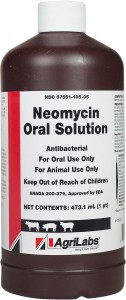Emergency Care Supplies…
While breeding for strong immune systems remains a top aspiration for responsible breeders, keeping a few medications on hand can make a tremendous difference in the recovery of a rabbit in need of emergency care. In addition, maintaining a good relationship with a qualified veterinarian, such as an exotic specialist, is extremely important. The combination, however, of having helpful medications on hand and having a veterinarian to provide professional emergency care instructions and/or assistance has helped save the lives of many rabbits in need of immediate assistance. If you don’t already have a rabbit savvy vet, we encourage you to obtain one as soon as possible so you can begin getting to know them. If you’re having a difficult time finding a good rabbit vet, please contact your nearest ARBA Club Representative for further assistance.
Below you will find a list of some of the items that we keep on hand for emergency purposes. Like all information on the web, the following medication list is NOT intended to be a suggestion, replacement, or partial substitution for professional veterinary care, but rather it’s a list of medications that you and your veterinarian may want to discuss. As always, it’s important to consult with a qualified veterinarian regarding your rabbit’s health care and emergency needs.
Immediate Care for Rabbits…
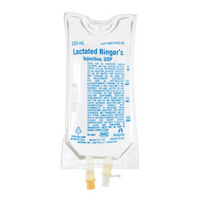 Lactated Ringer Fluids – to prevent and treat dehydration and improve GI tract motility.
Lactated Ringer Fluids – to prevent and treat dehydration and improve GI tract motility.
Administer: sub-q (under the skin) at a rate of 10cc/1-2 lbs or 25 cc/3-4 lb rabbit, 1-2x day depending on severity (2x for rabbits not drinking at all).For rabbits that are off feed, have scant, oblong, or no fecal droppings, diarrhea or mucoid enteritis, administer 30cc/lb. sub-q, 2x daily in conjuntion with metoclopramide (please see the below).
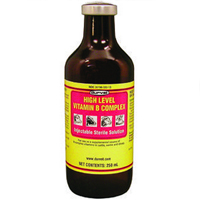
Liquid Vitamin B Complex – to stimulate appetite and help reduce stress during illness or prior to travel.
Administer: 0.025cc/lb. body weight or 0.1cc/4 lbs., sub-q, 1x daily.Note: Can be aministered in lactaged ringer fluid mixture.
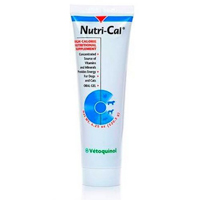 Nutra-Cal – a high calorie gel supplement for rabbits that are ill, not eating well, or off feed.
Nutra-Cal – a high calorie gel supplement for rabbits that are ill, not eating well, or off feed.
Administer: orally @ 1-2 cc every 6-12 hours for an adults.
Note: This is an excellent product to mix with rabbit feed for rabbits that are not eating to help keep ulcers from forming. Grind a tablespoon of pellets in a dedicated coffee grinder, mix in 1-2cc Nutra-Cal, and hydrate with water. Syringe feed at least 2 teaspoons of the mixture, twice to three times daily, until the rabbit is eating and has normal fecal droppings again.
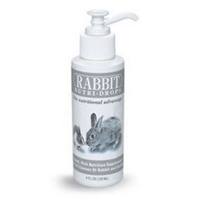 Nutra-Drops – a rapidly absorbed nutritional supplement for the treatment of ill rabbits.
Nutra-Drops – a rapidly absorbed nutritional supplement for the treatment of ill rabbits.
Administer: orally according to directions.
Digestive and Gastrointestinal Support….
 Questran (Cholestyramine) (Rx) – an extremely effective treatment for GI issues, like diarrhea, gastrointestinal stasis, and mucoid enteritis, and an effectual prophylactic measure used at half dose before travel.
Questran (Cholestyramine) (Rx) – an extremely effective treatment for GI issues, like diarrhea, gastrointestinal stasis, and mucoid enteritis, and an effectual prophylactic measure used at half dose before travel.
Questran works by sequestering life-threatening toxins, like clostridium, that result from an over-growth of undesirable bacteria in the hind gut, and by supporting the repopulation of beneficial gut flora. In turn, the reduction of harmful bacteria also buys critical time for gut motility drugs and other treatments to begin working.
Because Questran has a strong ability to adsorb substances in the gut lumen, always administer other medications at least 1 hour prior to Questran and no sooner than 4-6 hours afterward Questran or it may interfere with the absorption and/or effectiveness of the other drugs. Due to Questran’s hydrophilic properties, dehydration of intestinal contents can occur if it’s given with insufficient water. Questran is an orange-flavored treatment that most rabbits find very palatable.
Administer: Syringe 1 gram (approximately 1/2 tsp.) in 10-12 cc of water and give orally, twice a day for 5 days, to adults, or until normal fecal droppings appear. Treat kits using half-dose (1/4 tsp. in 5 cc water).
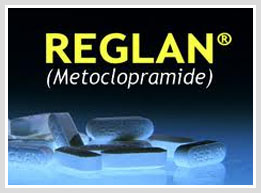 Reglan (Metoclopramide Hcl) (10 mg tablets, Rx) – used to help improve gut motility during times when droppings are small, declining, or absent. Also helpful to removing bacteria from the intestines during times of diarrhea and mucoid enteritis. For adult Hollands, syringe 1/4 tablet or 2.5 mg, crushed, and mixed in water 2x daily until droppings return to normal. Provide exercise and hay during treatment also.
Reglan (Metoclopramide Hcl) (10 mg tablets, Rx) – used to help improve gut motility during times when droppings are small, declining, or absent. Also helpful to removing bacteria from the intestines during times of diarrhea and mucoid enteritis. For adult Hollands, syringe 1/4 tablet or 2.5 mg, crushed, and mixed in water 2x daily until droppings return to normal. Provide exercise and hay during treatment also.
Liquid Metoclopramide 5mg/5ml liquid solution strength is also available by Rx. Administer 0.5cc/per lb. twice daily. Taper treatment off to 1x/day after fecal droppings return to normal and the rabbit is on full feed again.
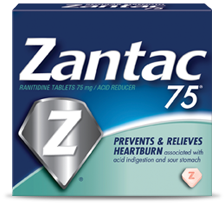 Zantac (Ranitidine) – used to treat ulcers, possible ulcers from thinning flesh and poor appetite, or as a prevention measure for rabbits who are off feed.
Zantac (Ranitidine) – used to treat ulcers, possible ulcers from thinning flesh and poor appetite, or as a prevention measure for rabbits who are off feed.
Administration/Treatment: 2mg/kg of body weight (or 0.91 cc/lb) twice daily. Zantac tablets can be purchased in 75 mg tabs. Completely dissolve in 7.5cc water to create a 1 mg per 0.1cc solution. Syringe 0.91cc/lb. or round up to 0.1cc/lb. For example, a 4 lb. rabbit would receive 0.37cc of a 1 mg/ml solution or you can round to 0.4cc if your syringe is larger.
Note: Ranitidine is also available in a pediatric, liquid suspension version (Rx). Please consult with your veternarian for more information.
 Sucralfate (1 gm tablet, Rx) – to aid in the healing of suspected ulcers when a rabbit is off feed for longer than 24 hours or not eating well for longer durations of time. Crush and dissolve 1/4 tablet in 2cc water and administer twice a day for five days to adults. Provide unlimited fiber and avoid stress.
Sucralfate (1 gm tablet, Rx) – to aid in the healing of suspected ulcers when a rabbit is off feed for longer than 24 hours or not eating well for longer durations of time. Crush and dissolve 1/4 tablet in 2cc water and administer twice a day for five days to adults. Provide unlimited fiber and avoid stress.
Note: This medicine may affect the ability to absorb other meds. Please consult with your veternarian before using.

Critical Care – a supplement that acts as a replacement for pellets and provides nutrients. Used for rabbits under stress who have stopped eating and need “critical care.” Administer orally according to directions.
Note: An excellent alternative to Critical Care is to grind rabbit pellets in a coffee grinder on the finest setting and then mix with water, Nutra-Cal, and prebiotic (Bio-Moss by Alltec). Cut the tip off a syringe, if needed, to make feeding easier. We prefer using the rabbits normal diet to supplement nutritional uptake because it’s safer for maintaining normal gastrointestinal flora than switching feeds. This is the same reason breeders are careful when transition to a new feed.
*Keeping some feed and fluids in the digestive system helps to keep it from shutting down and also reduces the risks of forming ulcers. This is one of the main reasons syringing Critical Care is helpful. It also contains prebiotics, like Bio-Mos, below.
 Bio-Mos – a unique product derived from a selected strain of Saccharomyces cerevisiae yeast. Bio-Mos was designed to feed the gastrointestinal tract, thereby maximizing recovery. The product also, “enhances feed efficiency, contributes to immune system development, participates in normalizing gut microflora, stimulates the natural defenses of the organism, reinforces the function of the digestive system…”
Bio-Mos – a unique product derived from a selected strain of Saccharomyces cerevisiae yeast. Bio-Mos was designed to feed the gastrointestinal tract, thereby maximizing recovery. The product also, “enhances feed efficiency, contributes to immune system development, participates in normalizing gut microflora, stimulates the natural defenses of the organism, reinforces the function of the digestive system…”
Administration: See directions and Critical Care suggestions above.
For more information on purchasing Bio-Mos, please click here.
Common Parasitic Disease Treatments…
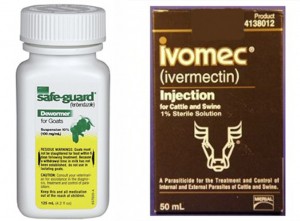
Safeguard & Ivomec – not only can rabbit breeders use Safeguard and Ivomec for deworming, as suggested on our Routine Needs page, but both products can also be used for treating rabbits with Wry Reck. The wry neck treatment period extends 28 days. Administer 0.2cc per lb. of liquid Safeguard (100 mg/ml strength) orally 1x daily for 28 consecutive days. On the 1st and 7th day of treatment, administer .1cc per lb. of 1% Injectable Ivomec orally (DO NOT administer IM or Sub-q). We have had great success with this treatment method.
 Revolution – used to treat rabbits with fur mites. For more information regarding Revolution, see our Routine Needs page.
Revolution – used to treat rabbits with fur mites. For more information regarding Revolution, see our Routine Needs page.
Note: Rabbits contaminated with fur mites should be treated once every 2 weeks for 3 treatments.
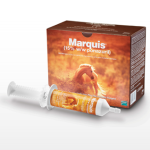 Toltrazuril/Ponazuril (Rx)- used to treat coccidia. This is the only medication known to completely eradicate all life stages of coccidia. Administer 50mg/kg, orally, once a day for 5 days. There is no need to repeat treatment. Baycox ® (toltrazuril) is a 5% liquid suspension (50mg/ml) and should be administered orally at a rate of 0.455 cc/lb. Marquis ® is a 15% antiprotozoal oral paste (150 mg/g). Dilution of Marquis for use in rabbits can be accomplished by mixing 20 mls Marquis paste + 10 mls water = 30 mls of 100 mg/ml solution. The mixture is good for 5 days; dispose of any left over solution.
Toltrazuril/Ponazuril (Rx)- used to treat coccidia. This is the only medication known to completely eradicate all life stages of coccidia. Administer 50mg/kg, orally, once a day for 5 days. There is no need to repeat treatment. Baycox ® (toltrazuril) is a 5% liquid suspension (50mg/ml) and should be administered orally at a rate of 0.455 cc/lb. Marquis ® is a 15% antiprotozoal oral paste (150 mg/g). Dilution of Marquis for use in rabbits can be accomplished by mixing 20 mls Marquis paste + 10 mls water = 30 mls of 100 mg/ml solution. The mixture is good for 5 days; dispose of any left over solution.
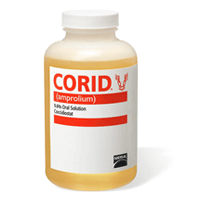 Corid – used to treat rabbits for Coccidiosis. Administer according to directions. For more information regarding Corid, see our Routine Needs page.
Corid – used to treat rabbits for Coccidiosis. Administer according to directions. For more information regarding Corid, see our Routine Needs page.
Note: Research shows Corid is unable to remove the entire coccidia colony. This leaves resistant strains behind that grow and cause greater damage. Please consider treating Coccidia with Toltrazuril, which is much more effective and safe.
Antibiotic Support….
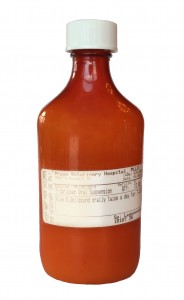 Trimethoprim Sulfate (Tribrissen) – an effective broad-spectrum antibiotic with minimal effect on the normal flora of the GI tract. Trimethoprim Sulfate provides excellent activity against most gram negative organisms and Staphylococci which makes it an excellent treatment choice for rabbits with known and unknown sources of infections including coccidiosis, respiratory, UTI’s and retained fetus, staph, etc..
Trimethoprim Sulfate (Tribrissen) – an effective broad-spectrum antibiotic with minimal effect on the normal flora of the GI tract. Trimethoprim Sulfate provides excellent activity against most gram negative organisms and Staphylococci which makes it an excellent treatment choice for rabbits with known and unknown sources of infections including coccidiosis, respiratory, UTI’s and retained fetus, staph, etc..
Administer 0.2cc per lb., orally, 2x daily, for 10-14 days.
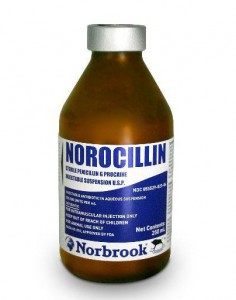
Penicillin G Procaine (a.k.a. Pen G) – used to treat rabbits with vent disease (syphilis). Administer 40,000 IU/kg (or 0.06 cc/per lb. of 300,000 IU/kg Pen G solution), sub-q, 1x daily, for 5 days. Do NOT administer orally or topically as doing so causes GI tract imbalance that results in death! The penicillin must also NEVER be injected intramuscularly due which increases the risk of fatality if it hits a blood vessel! Penicillin should be ONLY given subcutaneously, or under the neck skin, and the plunger pulled back to be sure you have not hit a blood vessel. If injected into a blood vessel, it can cause a blockage, initiating a stroke; this can result in death or very serious injury to the brain and other organs.
Please be aware, vent disease is like syphilis in people, which has primary, secondary, latent (hidden or silent), tertiary (advanced complications), and congenital phases. We have unknowingly purchased rabbits in the latent stage who, in turn, infected members of our herd through breeding. For these reasons combined with the fact that there are always risks associated the use of Penicillin, we treat all new rabbits before introducing them into our herd.
Note: Some people also use long-lasting, combo versions of Procaine Penicillin G and Penicillin G Benzathine, known as Dura-Pen or Pen BP-48, to treat vent disease. However, data suggests these combo treatments are not effective for people. Continuously, we found the combo treatment actually increase the risks of GI issues and death. The treatment above was recommended by our rabbit savvy, exotic specialist veterinarian. Please consult with your own veterinarian regarding treatments best suited to meet the needs of your herd.
 Baytril (Rx) – antibiotic used to treat severe infections. Administer 0.2ml/kg under the skin twice a day for five days to adults. To avoid burning sensation during administrating and potential fur loss at the injection site, draw up the appropriate dose of Baytril and then draw up an equal amount of saline solution into the same syringe and gently mix by tilting the syringe back and forth. Provide unlimited fiber and avoid stress.
Baytril (Rx) – antibiotic used to treat severe infections. Administer 0.2ml/kg under the skin twice a day for five days to adults. To avoid burning sensation during administrating and potential fur loss at the injection site, draw up the appropriate dose of Baytril and then draw up an equal amount of saline solution into the same syringe and gently mix by tilting the syringe back and forth. Provide unlimited fiber and avoid stress.
Neomycin – used to treat mucoid enteritis. Mix one teaspoon of neomycin to one gallon of water. Give water mixture to rabbit until the mucoid enteritis clears up.
Optical Support….
Tobramycin (.3% solution, Rx) – used to treat bacterial infections of the 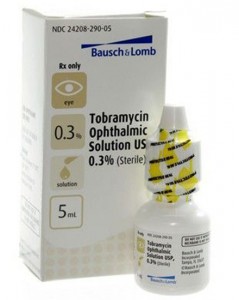 eye, a concentration of protein that appears as a cloudy area on the iris (colored part of the eye). Apply two drops into the affected eye twice daily for 7 – 10 days.
eye, a concentration of protein that appears as a cloudy area on the iris (colored part of the eye). Apply two drops into the affected eye twice daily for 7 – 10 days.
Note: Eye infections can be a symptom of e.cuniculi contamination.
Reproduction Support….
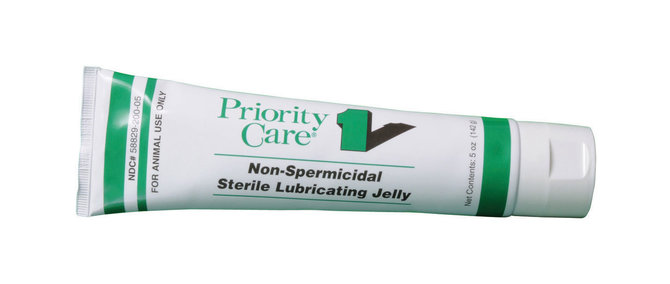 OB Lubricant – used for kindling does with dystocia due to a stuck kit. Syringe 1cc of OB lubricant (which is preferred or jelly may be used) into the birth canal to help make rotation of the kit possible, if necessary, making the process of removing the kit much more likely and safer for the doe. It’s important to note, that you should ever attempt to pull a stuck kit except with the aid of a lubricant and only during a contraction while in a natural kindling position. Also, some stuck kits can not be manipulated and/or removed even with the use of a lubricant, but instead will soften in time so that the doe will be able to pass them on her own within a few days. In such a case, we usually cover the doe for infection by treating her with Trimethoprim Sulfate (Tribrissen) as directed (above). OB Lubricants can be purchased at farm and ranch stores.
OB Lubricant – used for kindling does with dystocia due to a stuck kit. Syringe 1cc of OB lubricant (which is preferred or jelly may be used) into the birth canal to help make rotation of the kit possible, if necessary, making the process of removing the kit much more likely and safer for the doe. It’s important to note, that you should ever attempt to pull a stuck kit except with the aid of a lubricant and only during a contraction while in a natural kindling position. Also, some stuck kits can not be manipulated and/or removed even with the use of a lubricant, but instead will soften in time so that the doe will be able to pass them on her own within a few days. In such a case, we usually cover the doe for infection by treating her with Trimethoprim Sulfate (Tribrissen) as directed (above). OB Lubricants can be purchased at farm and ranch stores.
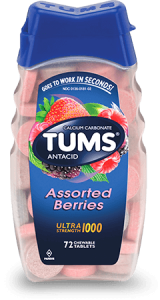 TUMs – used to prevent pregnant does too low in calcium from developing “milk fever” (as known in cattle) before and/or after kindling. Some does can be too low in calcium before and/or after kindling, and as a result can develop seizures (or hay fever), which can be fatal. From day 28 of gestation until 3 days after kindling, we give one TUM 2x daily to our does. You can either break the TUM into little pieces and place it in the doe’s feed dish to eat, or you can crush the TUM into a powdered form and syringe it to your doe orally by adding a few 1cc syringes of water to your powder. However, we prefer to break the TUM into small pieces. We recommend the berry flavor TUMs, as the taste is more palatable to does.
TUMs – used to prevent pregnant does too low in calcium from developing “milk fever” (as known in cattle) before and/or after kindling. Some does can be too low in calcium before and/or after kindling, and as a result can develop seizures (or hay fever), which can be fatal. From day 28 of gestation until 3 days after kindling, we give one TUM 2x daily to our does. You can either break the TUM into little pieces and place it in the doe’s feed dish to eat, or you can crush the TUM into a powdered form and syringe it to your doe orally by adding a few 1cc syringes of water to your powder. However, we prefer to break the TUM into small pieces. We recommend the berry flavor TUMs, as the taste is more palatable to does.
Nutritional Support following herd losses…
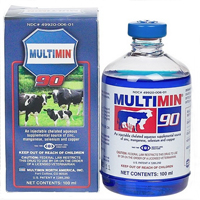 Multi-Min (Rx) – not intended for use in rabbits. It can be administered successfully ONLY under the supervision of a qualified veterinarian to help correct copper deficiency that typically results from a dietary copper: zinc: molybdenum imbalance. Sadly, copper levels are diagnosed via liver biopsy. Since copper toxicity is as dangerous as copper deficiency, never attempt to correct copper levels without professional guidance. Copper deficiency and toxicity symptoms include underdeveloped kits, premature kindling, and GI issues (diarrhea) especially in younger kits.
Multi-Min (Rx) – not intended for use in rabbits. It can be administered successfully ONLY under the supervision of a qualified veterinarian to help correct copper deficiency that typically results from a dietary copper: zinc: molybdenum imbalance. Sadly, copper levels are diagnosed via liver biopsy. Since copper toxicity is as dangerous as copper deficiency, never attempt to correct copper levels without professional guidance. Copper deficiency and toxicity symptoms include underdeveloped kits, premature kindling, and GI issues (diarrhea) especially in younger kits.
Other medications may be added soon!
Medication Dosage Formula
Step 1: Treatment Rate ÷ Concentration of Medication = Dosage Rate
Step 2: Dosage Rate x Weight of Animal = Amount Needed for Treatment
5% Toltrazuril Example:
Dosage Rate = 50mg/kg
Toltrazuril Concentration = 50mg/mL
Animal Weight = 1 kg (2.2lbs) OR 1 lb
Note: 1 mL = 1 cc
Dosage Formula in kg: (50mg/kg ÷ 50mg/1mL) = 50mg/kg x 1mL/50mg = 1mL/kg
Treatment in kg: 1mL needed per 1 kg of body weight
OR
Formula in lb: (22.73mg/lb ÷ 50mg/1mL) = 22.73mg/lb x 1mL/50mg = 0.455mL/lb
Treatment in lb: 0.455mL needed per 1 lb of body weight
| Classification | Name | Use | Precautions |
|---|---|---|---|
